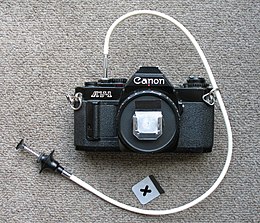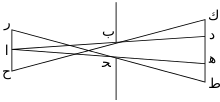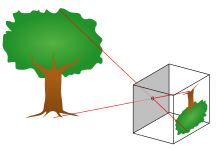Who Invented The Pinhole Camera

A home-made pinhole camera lens
A pinhole photographic camera is a simple camera without a lens just with a tiny aperture (the then-chosen pinhole)—effectively a light-proof box with a small hole in 1 side. Light from a scene passes through the aperture and projects an inverted image on the opposite side of the box, which is known as the camera obscura effect. The size of the images depends on the altitude between the object and the pinhole.
History [edit]
Camera obscura [edit]
The camera obscura or pinhole image is a natural optical phenomenon. Early known descriptions are found in the Chinese Mozi writings (circa 500 BCE)[one] and the Aristotelian Issues (circa 300 BCE – 600 CE).[2]

A diagram depicting Ibn al-Haytham's observations of light's behaviour through a pinhole

Early pinhole camera. Light enters a dark box through a minor pigsty and creates an inverted image on the wall reverse the pigsty.[3]
Ibn al-Haytham (965–1039), an Arab physicist also known as Alhazen, described the camera obscura outcome. Over the centuries others started to experiment with it, mainly in dark rooms with a small opening in shutters, more often than not to report the nature of calorie-free and to safely watch solar eclipses.[4]
Giambattista Della Porta wrote in 1558 in his Magia Naturalis about using a concave mirror to project the image onto newspaper and to employ this as a drawing assistance.[v] However, at about the same time, the use of a lens instead of a pinhole was introduced. In the 17th century, the photographic camera obscura with a lens became a pop drawing aid that was further developed into a mobile device, first in a lilliputian tent and later on in a box. The photographic camera, every bit developed early in the 19th century, was basically an adaptation of the box-type camera obscura with a lens.
The term "pin-hole" in the context of optics was found in James Ferguson's 1764 volume Lectures on select subjects in mechanics, hydrostatics, pneumatics, and optics.[6] [7]
Early pinhole photography [edit]
The start known description of pinhole photography is found in the 1856 book The Stereoscope by Scottish inventor David Brewster, including the description of the idea equally "a camera without lenses, and with only a pin-hole".
Sir William Crookes and William de Wiveleslie Abney were other early photographers to try the pinhole technique.[8]
Moving picture and integral photography experiments [edit]
According to inventor William Kennedy Dickson, the outset experiments directed at moving pictures past Thomas Edison and his researchers took place around 1887 and involved "microscopic pin-point photographs, placed on a cylindrical shell". The size of the cylinder corresponded with their phonograph cylinder as they wanted to combine the moving images with audio recordings. Issues arose in recording clear pictures "with phenomenal speed" and the "coarseness" of the photographic emulsion when the pictures were enlarged. The microscopic pin-point photographs were presently abandoned.[ix] In 1893 the Kinetoscope was finally introduced with moving pictures on celluloid film strips. The camera that recorded the images, dubbed Kinetograph, was fitted with a lens.
Eugène Estanave experimented with integral photography, exhibiting a result in 1925 and publishing his findings in La Nature. After 1930 he chose to continue his experiments with pinholes replacing the lenticular screen.[x]
Usage [edit]
The image of a pinhole photographic camera may be projected onto a translucent screen for a real-fourth dimension viewing (used for safe observation of solar eclipses) or to trace the paradigm on paper. But information technology is more than ofttimes used without a translucent screen for pinhole photography with photographic film or photographic paper placed on the surface opposite to the pinhole discontinuity.
A common apply of pinhole photography is to capture the movement of the sunday over a long period of time. This type of photography is called solarigraphy. Pinhole photography is used for creative reasons, but likewise for educational purposes to permit pupils acquire well-nigh, and experiment with, the basics of photography.
Pinhole cameras with CCDs (charge-coupled devices) are sometimes used for surveillance because they are difficult to detect.
Related cameras, image forming devices, or developments from it include Franke's widefield pinhole camera, the pinspeck camera, and the pinhead mirror.
Modern manufacturing has enabled the production of high quality pinhole lenses[11] that can be practical to digital cameras; allowing photographers and videographers to achieve the photographic camera obscura effect.
Characteristics of pinhole photographic camera photography [edit]
- As pinhole photographs take nearly infinite depth of field, everything appears in focus.
- Every bit there's no lens distortion, broad-bending images remain absolutely rectilinear.
- Exposure times are commonly long, resulting in move blur around moving objects and the absence of objects that moved too fast.
Other special features tin be built into pinhole cameras such as the ability to take double images by using multiple pinholes, or the ability to have pictures in cylindrical or spherical perspective by curving the motion picture plane.
Construction [edit]

A home-made pinhole photographic camera (on the left), wrapped in black plastic to prevent calorie-free leaks, and related developing supplies
Pinhole cameras can be handmade by the photographer for a particular purpose. In its simplest form, the photographic pinhole camera can consist of a light-tight box with a pinhole in one end, and a piece of moving-picture show or photographic paper wedged or taped into the other end. A flap of cardboard with a tape hinge can exist used as a shutter. The pinhole may be punched or drilled using a sewing needle or small diameter flake through a piece of tinfoil or thin aluminum or contumely canvass. This piece is then taped to the inside of the light-tight box behind a hole cut through the box. A cylindrical oatmeal container may be fabricated into a pinhole camera.
The interior of an constructive pinhole camera is blackness to avert whatever reflection of the inbound light onto the photographic material or viewing screen.[12]
Pinhole cameras can be constructed with a sliding pic holder or dorsum so the altitude between the picture and the pinhole tin can exist adjusted. This allows the angle of view of the camera to be inverse and also the effective f-stop ratio of the photographic camera. Moving the picture closer to the pinhole will result in a broad angle field of view and shorter exposure time. Moving the flick farther away from the pinhole will result in a telephoto or narrow-angle view and longer exposure time.
Pinhole cameras can also be constructed by replacing the lens assembly in a conventional camera with a pinhole. In particular, compact 35 mm cameras whose lens and focusing assembly have been damaged can be reused as pinhole cameras—maintaining the apply of the shutter and film winding mechanisms. Every bit a upshot of the enormous increase in f-number, while maintaining the same exposure time, one must use a fast film in direct sunshine.
Pinholes (homemade or commercial) tin can exist used in place of the lens on an SLR. Use with a digital SLR allows metering and composition by trial and error, and is effectively complimentary, so is a popular way to endeavor pinhole photography.[13]
Choice of pinhole size [edit]
Up to a certain point, the smaller the hole, the sharper the paradigm, but the dimmer the projected paradigm. Optimally, the size of the aperture should exist 1/100 or less of the distance between it and the projected image.
Within limits, a small pinhole through a sparse surface will effect in a sharper image resolution because the projected circle of confusion at the image plane is practically the same size as the pinhole. An extremely small hole, however, tin produce significant diffraction effects and a less clear paradigm due to the moving ridge properties of calorie-free.[xiv] Additionally, vignetting occurs as the diameter of the pigsty approaches the thickness of the fabric in which information technology is punched, considering the sides of the pigsty obstruct the light entering at annihilation other than 90 degrees.
The best pinhole is perfectly round (since irregularities cause higher-gild diffraction effects) and in an extremely thin piece of material. Industrially produced pinholes benefit from laser etching, only a hobbyist can still produce pinholes of sufficiently high quality for photographic work.
A method of computing the optimal pinhole diameter was offset published by Joseph Petzval in 1857. The smallest possible diameter of the image indicate and therefore the highest possible image resolution and the sharpest image are given when:[fifteen]
(Where d is the pinhole diameter, f is the altitude from pinhole to image plane or "focal length" and λ is the wavelength of light.)
The kickoff to employ wave theory to the problem was Lord Rayleigh in 1891. Just due to some incorrect and capricious deductions he arrived at:[16]
So his optimal pinhole was approximatively 1/3 bigger than Petzval'south.
The right optimum can exist found with Fraunhofer approximation of the diffraction blueprint behind a round aperture at:
This may be shortened to: (When d and f in millimetres and λ = 550 nm = 0.00055 mm, corresponding to yellowish-green.)
For a pinhole-to-film distance of one inch or 25.4 mm, this works out to a pinhole of 0.185 mm (185 microns) in diameter. For f= 50 mm the optimal diameter is 0.259 mm.
The depth of field is basically infinite, but this does not mean that no optical blurring occurs. The infinite depth of field means that prototype blur depends not on object distance just on other factors, such equally the altitude from the aperture to the film plane, the discontinuity size, the wavelength(s) of the calorie-free source, and motion of the subject field or canvas. Additionally, pinhole photography tin not avert the effects of haze.

An example of a xx-minute exposure taken with a pinhole photographic camera

A photograph taken with a pinhole photographic camera using an exposure time of 2s

A graph of the resolution limit of the pinhole photographic camera equally a function of focal length (image distance).
In the 1970s, Young measured the resolution limit of the pinhole camera every bit a role of pinhole diameter[17] and later published a tutorial in The Physics Teacher.[18] Partly to enable a diversity of diameters and focal lengths, he defined two normalized variables: pinhole radius divided by resolution limit, and focal length divided by the quantity s two/λ, where s is the radius of the pinhole and λ is the wavelength of the light, typically about 550 nm. His results are plotted in the effigy.
On the left-side of the graph, the pinhole is big, and geometric optics applies; the resolution limit is about 1.five times the radius of the pinhole. (Spurious resolution is besides seen in the geometric-optics limit.) On the right-side, the pinhole is small, and Fraunhofer diffraction applies; the resolution limit is given by the far-field diffraction formula shown in the graph and at present increases every bit the pinhole is made smaller. In the region of near-field diffraction (or Fresnel diffraction), the pinhole focuses the light slightly, and the resolution limit is minimized when the focal length f (the distance betwixt the pinhole and the motion-picture show plane) is given by f = s 2/λ. At this focal length, the pinhole focuses the low-cal slightly, and the resolution limit is virtually two/3 of the radius of the pinhole. The pinhole, in this case, is equivalent to a Fresnel zone plate with a unmarried zone. The value s 2/λ is in a sense the natural focal length of the pinhole.
The relation f = south 2/λ yields an optimum pinhole diameter d = 2√ fλ , so the experimental value differs slightly from the estimate of Petzval, above.
Computing the f-number and required exposure [edit]

A fire hydrant photographed by a pinhole camera fabricated from a shoe box, exposed on photographic paper to create the negative paradigm (superlative). The positive paradigm (bottom) was created digitally from the negative image. The length of the exposure was 40 seconds. In that location is noticeable flaring in the bottom-right corner of the image, likely due to inapplicable calorie-free inbound the camera box.
The f-number of the photographic camera may be calculated by dividing the altitude from the pinhole to the imaging plane (the focal length) by the diameter of the pinhole. For example, a camera with a 0.5 mm diameter pinhole, and a 50 mm focal length would have an f-number of 50/0.5, or 100 (f/100 in conventional annotation).
Due to the large f-number of a pinhole camera, exposures will oftentimes run across reciprocity failure.[19] One time exposure fourth dimension has exceeded about 1 2nd for picture or 30 seconds for newspaper, one must compensate for the breakdown in linear response of the film/paper to intensity of illumination past using longer exposures.
Exposures projected on to mod low-cal-sensitive photographic film can typically range from five seconds upwards to every bit much as several hours, with smaller pinholes requiring longer exposures to produce the same size paradigm. Because a pinhole camera requires a lengthy exposure, its shutter may be manually operated, as with a flap made of opaque textile to cover and uncover the pinhole.
Coded apertures [edit]
A non-focusing coded-discontinuity optical arrangement may be idea of as multiple pinhole cameras in conjunction. By adding pinholes, light throughput and thus sensitivity are increased. However, multiple images are formed, usually requiring computer deconvolution.
Modernistic day interest in pinhole photography [edit]
A revival in popularity has go evident in recent years with the success of Kickstarter crowdfunding campaigns offer a range of pinhole photography products. From a camera crafted from wood[20] to the Pinhole Pro[xi] - a sleek lens designed for DSLR and MILC digital cameras - these projects have fatigued investment from thousands of enthusiastic backers to enhance hundreds of thousands of dollars.
Natural pinhole miracle [edit]

A pinhole camera issue tin sometimes occur naturally. Small "pinholes" formed by the gaps between overlapping tree leaves will create replica images of the dominicus on flat surfaces. During an eclipse, this produces small crescents in the case of a partial eclipse, or hollow rings in the example of an annular eclipse.
Observation [edit]
Worldwide Pinhole Photography Twenty-four hours is observed on the concluding Dominicus of April, every year.[21]
Photographers using the technique [edit]
- Billy Childish
- George Davison
- Barbara Ess
- Wolf Howard
- Steven Pippin
- Jesse Richards
Run into likewise [edit]
- Camera obscura (ordinarily employs a lens)
- Dirkon
- Henry Fox Talbot
- Ibn al-Haytham
- Nautilus (whose pinhole eye functions equally a photographic camera obscura)
- Pinhole camera model
- Pinhole glasses
- Pinhole occluder, a similar device used past ophthalmologists
- Spatial filter
- The Swell Picture
- Zone plate
References [edit]
- ^ "CS194-26: proj2". inst.eecs.berkeley.edu . Retrieved 2022-01-07 .
- ^ "Camera Obscura: Antecedent of Mod Photography | Encyclopedia.com". www.encyclopedia.com . Retrieved 2022-01-07 .
- ^ Kirkpatrick, Larry D.; Francis, Gregory E. (2007). "Light". Physics: A Globe View (six ed.). Belmont, California: Thomson Brooks/Cole. p. 339. ISBN978-0-495-01088-iii.
- ^ Plott, John C. (1984). Global History of Philosophy: The Period of scholasticism (part one). p. 460. ISBN978-0-89581-678-8.
- ^ Zik, Yaakov; Hon, Giora (10 February 2019). "Claudius Ptolemy and Giambattista Della Porta: Two Contrasting Conceptions of Optics". arXiv:1902.03627 [physics.hist-ph].
- ^ "Nick'due south pinhole photography". idea.uwosh.edu . Retrieved 29 January 2018.
- ^ Ferguson, James (1764). Lectures on select subjects in mechanics, hydrostatics, pneumatics, and optics with the utilise of the globes, the art of dialing, and the calculation of the mean times of new and total moone and eclipses.
- ^ "Pinhole photography history". photo.net. Archived from the original on 2017-02-02. Retrieved 29 Jan 2018.
- ^ History of the kinetograph, kinetoscope, & kinetophonograph [by] West. K. L. Dickson and Antonia Dickson. Literature of movie theatre. Arno Printing. 1970. hdl:2027/mdp.39015002595158. ISBN9780405016110.
- ^ Timby, Kim (31 July 2015). 3D and Animated Lenticular Photography. ISBN9783110448061.
- ^ a b "Pinhole Pro Lens past Thingyfy". 2018.
- ^ "How to Make and Use a Pinhole Photographic camera". Archived from the original on 2016-03-05.
- ^ "V3 - digital transformation news, analysis and insight". v3.co.uk . Retrieved 18 October 2018.
- ^ Hecht, Eugene (1998). "v.7.six The Photographic camera". Optics (3rd ed.). ISBN0-201-30425-2.
- ^ Petzval, Joseph Maximilian (1857), "Bericht über dioptrische Untersuchungen". Vortrag vom 23. Juli 1857; in: Sitzungsberichte der kaiserlichen Akademie der Wissenschaften, mathematisch-naturwissenschaftliche Classe, vol. XXVI, Due south. 33-90
- ^ Lord Rayleigh Sec. R.S. (1891), X."On Pin-pigsty Photography", in: Philosophical Mag, Series 5, Volume 31, 1891 – Consequence 189, pp.87-99
- ^ Young, M. (1971). "Pinhole optics". Applied Eyes. ten (12): 2763–2767. Bibcode:1971ApOpt..10.2763Y. doi:10.1364/ao.ten.002763. PMID 20111427.
- ^ Young, Matt (1989). "The pinhole camera: Imaging without lenses or mirrors". The Physics Teacher. 27 (ix): 648–655. Bibcode:1989PhTea..27..648Y. doi:x.1119/1.2342908.
- ^ breslin, nancy a. "Nancy Breslin'due south pinhole camera exposure tips". www.nancybreslin.com . Retrieved 29 January 2018.
- ^ "Wooden pinhole photographic camera past ONDU". 2015.
- ^ "Worldwide Pinhole Photography Twenty-four hour period". pinholeday.org.
Further reading [edit]
- Eric Renner Pinhole Photography: From Historic Technique to Digital Application [ ISBN missing ]
External links [edit]
![]() Media related to Pinhole cameras at Wikimedia Commons
Media related to Pinhole cameras at Wikimedia Commons
- pinhole.cz
- Pinhole Photography by Vladimir Zivkovic
- Worldwide Pinhole Photography Twenty-four hours website
- An easy way to convert a DSLR to a pinhole camera
- Pinhole Photography and Photographic camera Design Calculators
- Illustrated history of cinematography
- Oregon Fine art Beat: Pinhole Photos past Zeb Andrews
- Ceremonious War 150 Pinhole Project by Michael Falco
Source: https://en.wikipedia.org/wiki/Pinhole_camera#:~:text=The%20first%20known%20description%20of,only%20a%20pin%2Dhole%22.
Posted by: lozathatrated.blogspot.com





0 Response to "Who Invented The Pinhole Camera"
Post a Comment